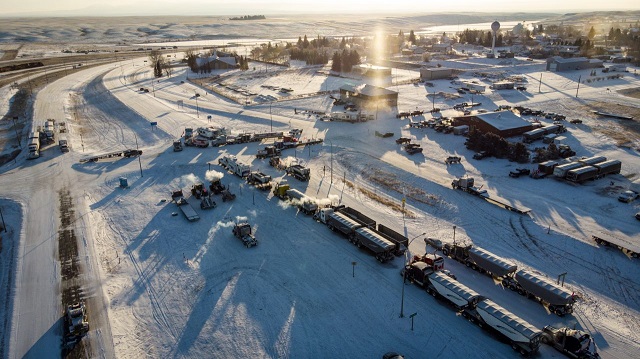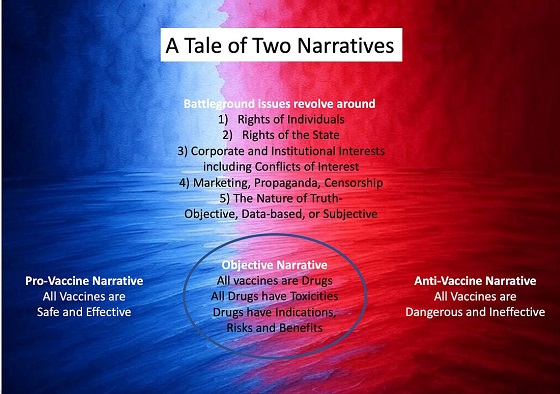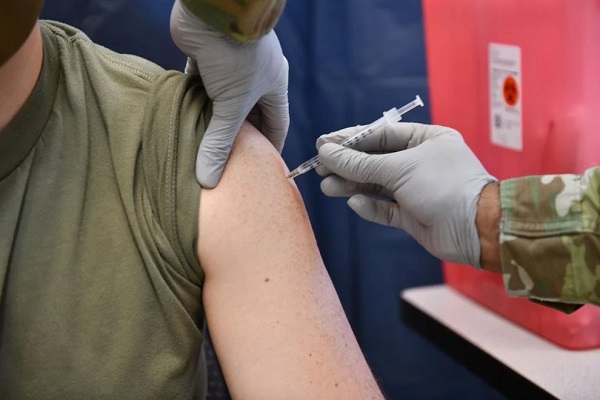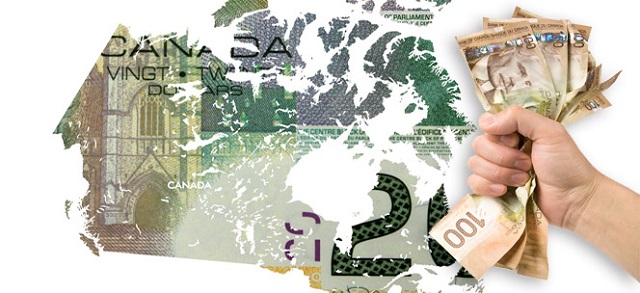Alberta
‘Coutts Two’ Verdict: Bail and Mischief

Protesters demonstrating against COVID-19 mandates and restrictions gather as a truck convoy blocks the highway at the Canada-U.S. border crossing in Coutts, Alta., on Feb. 2, 2022. The Canadian Press/Jeff McIntosh
From the Frontier Centre for Public Policy
By Ray McGinnis
Imagine spending over two years behind bars, only to be told the evidence never supported the charges against you.
On Aug. 2, a Lethbridge jury found Chris Carbert and Tony Olienick not guilty of the most serious charge of conspiracy to commit murder of police officers. However, though they were declared innocent, the conspiracy charge was the basis for their being held in remand for at least 925 days. They were denied bail based on this charge.
The sentencing hearing for other charges against Carbert and Olienick is taking place this week.
Granting Bail Typical for Serious Offences
In Canada, when someone is charged with committing a crime, they’re released on bail. This includes those charged with murder. For example, in September 2021, 31-year-old Umar Zameer was released on bail after being charged with the first-degree murder of Toronto Police Constable Jeffrey Northrup.
A case of double murder in the city of Mission in B.C.’s Fraser Valley concerned the deaths of Lisa Dudley and her boyfriend Guthrie McKay. Tom Holden, accused of first-degree murder in the case, was released on bail.
Conditions for not Granting Bail
Why do we release people from custody after being charged with a crime? Why don’t we hold people indefinitely? It’s been a Canadian tradition that there’s a process in place to which we adhere. Does the person charged with a crime seem to present a risk of repeating an offence? Carbert and Olienick hadn’t previously committed the offence(s) they were charged with. They didn’t have any criminal records for any violence. So, the likelihood of repetition of offence didn’t apply.
Another reason for denying bail is flight risk. But the Crown agreed neither of these men posed a flight risk. If you’re not clear about the identity of the person you’ve arrested, you can hold them in custody. But the Crown and the RCMP were certain of the identity of these men.
How about denying bail for evidence protection? If let go, was it possible the Crown or RCMP would lose evidence, and they needed to keep Carbert and Olienick in remand? No.
Were Carbert or Olienick considered a danger to the public? No. They had no past history of committing violent crimes, so in the case of the Coutts Two this was not a reason to deny bail.
The Crown insisted the pair be denied bail because their release would undermine confidence in the judicial system. Due to the seriousness of the offences the pair were charged with, releasing them would put the legal system into disrepute. But this is a circular argument. In authoritarian countries, police may arrest citizens on serious charges they’re not guilty of and leave them in prison indefinitely.
Granting Bail Goes Back to Magna Carta
Since the Magna Carta was signed in 1215, western judicial institutions have allowed those charged with a crime to be presumed innocent until proven guilty. With that provision comes the right to bail and a speedy trial. When citizens are accused of a crime and left to rot in prison without having their day in court, their spirits can be broken and persuaded to agree to plead guilty even when they are innocent.
Unindicted Co-conspirators Never Interviewed
During the trial, the Crown repeatedly named a list of unindicted co-conspirators. Each had a licence to carry a weapon in public for years. None of them were ever searched. None of them were ever interviewed. None of the alleged co-conspirators received any communication from the RCMP, or other authorities, about their possible connection to a conspiracy to murder police officers. However, the list of names provided for some legal theatre in the court added to the ominous scale of the supposed conspiracy to murder police officers.
Intelligence
Former career police officer Vincent Gircys had standing in the Justice Mosley decision. The judge ruled in January 2024 that the government’s invocation of the Emergencies Act in February 2022 to end the convoy protests was unconstitutional.
After the Coutts Two verdict, Gircys was concerned about the intelligence. There was a disconnect between the conspiracy charge and the evidence the Crown brought to trial. Gircys stated, “It’s really important to find where that disconnect is. Because of faulty intelligence? False intelligence? Fabricated intelligence? The evidence that they (RCMP) do have would all be logged, gathered, and time-lined. And that goes to what evidence was not gathered? … How could that information have been laid in the first place? How could the Crown have proceeded with this case to begin with?”
The Coutts Two were found not guilty of conspiracy to commit murder. But by the time they are sentenced on the other charges this week, they will have spent at least 925 days in custody. What does this mean for innocent until proven guilty?
Ray McGinnis is a Senior Fellow with the Frontier Centre for Public Policy. His forthcoming book is “Unjustified: The Emergencies Act and the Inquiry that Got It Wrong.”
Alberta
Made in Alberta! Province makes it easier to support local products with Buy Local program

Show your Alberta side. Buy Local. |
When the going gets tough, Albertans stick together. That’s why Alberta’s government is launching a new campaign to benefit hard-working Albertans.
Global uncertainty is threatening the livelihoods of hard-working Alberta farmers, ranchers, processors and their families. The ‘Buy Local’ campaign, recently launched by Alberta’s government, encourages consumers to eat, drink and buy local to show our unified support for the province’s agriculture and food industry.
The government’s ‘Buy Local’ campaign encourages consumers to buy products from Alberta’s hard-working farmers, ranchers and food processors that produce safe, nutritious food for Albertans, Canadians and the world.
“It’s time to let these hard-working Albertans know we have their back. Now, more than ever, we need to shop local and buy made-in-Alberta products. The next time you are grocery shopping or go out for dinner or a drink with your friends or family, support local to demonstrate your Alberta pride. We are pleased tariffs don’t impact the ag industry right now and will keep advocating for our ag industry.”
Alberta’s government supports consumer choice. We are providing tools to help folks easily identify Alberta- and Canadian-made foods and products. Choosing local products keeps Albertans’ hard-earned dollars in our province. Whether it is farm-fresh vegetables, potatoes, honey, craft beer, frozen food or our world-renowned beef, Alberta has an abundance of fresh foods produced right on our doorstep.
Quick facts
- This summer, Albertans can support local at more than 150 farmers’ markets across the province and meet the folks who make, bake and grow our food.
- In March 2023, the Alberta government launched the ‘Made in Alberta’ voluntary food and beverage labelling program to support local agriculture and food sectors.
- Through direct connections with processors, the program has created the momentum to continue expanding consumer awareness about the ‘Made in Alberta’ label to help shoppers quickly identify foods and beverages produced in our province.
- Made in Alberta product catalogue website
Related information
Alberta
Province to expand services provided by Alberta Sheriffs: New policing option for municipalities

Expanding municipal police service options |
Proposed amendments would help ensure Alberta’s evolving public safety needs are met while also giving municipalities more options for local policing.
As first announced with the introduction of the Public Safety Statutes Amendment Act, 2024, Alberta’s government is considering creating a new independent agency police service to assume the police-like duties currently performed by Alberta Sheriffs. If passed, Bill 49 would lay additional groundwork for the new police service.
Proposed amendments to the Police Act recognize the unique challenges faced by different communities and seek to empower local governments to adopt strategies that effectively respond to their specific safety concerns, enhancing overall public safety across the province.
If passed, Bill 49 would specify that the new agency would be a Crown corporation with an independent board of directors to oversee its day-to-day operations. The new agency would be operationally independent from the government, consistent with all police services in Alberta. Unlike the Alberta Sheriffs, officers in the new police service would be directly employed by the police service rather than by the government.
“With this bill, we are taking the necessary steps to address the unique public safety concerns in communities across Alberta. As we work towards creating an independent agency police service, we are providing an essential component of Alberta’s police framework for years to come. Our aim is for the new agency is to ensure that Albertans are safe in their communities and receive the best possible service when they need it most.”
Additional amendments would allow municipalities to select the new agency as their local police service once it becomes fully operational and the necessary standards, capacity and frameworks are in place. Alberta’s government is committed to ensuring the new agency works collaboratively with all police services to meet the province’s evolving public safety needs and improve law enforcement response times, particularly in rural communities. While the RCMP would remain the official provincial police service, municipalities would have a new option for their local policing needs.
Once established, the agency would strengthen Alberta’s existing policing model and complement the province’s current police services, which include the RCMP, Indigenous police services and municipal police. It would help fill gaps and ensure law enforcement resources are deployed efficiently across the province.
Related information
-

 Bruce Dowbiggin2 days ago
Bruce Dowbiggin2 days agoIs HNIC Ready For The Winnipeg Jets To Be Canada’s Heroes?
-

 COVID-192 days ago
COVID-192 days agoCOVID virus, vaccines are driving explosion in cancer, billionaire scientist tells Tucker Carlson
-

 Dr. Robert Malone2 days ago
Dr. Robert Malone2 days agoThe West Texas Measles Outbreak as a Societal and Political Mirror
-

 illegal immigration2 days ago
illegal immigration2 days agoDespite court rulings, the Trump Administration shows no interest in helping Abrego Garcia return to the U.S.
-

 Health2 days ago
Health2 days agoHorrific and Deadly Effects of Antidepressants
-

 2025 Federal Election2 days ago
2025 Federal Election2 days agoConservative MP Leslyn Lewis warns Canadian voters of Liberal plan to penalize religious charities
-

 2025 Federal Election1 day ago
2025 Federal Election1 day agoEuthanasia is out of control in Canada, but nobody is talking about it on the campaign trail
-

 Education1 day ago
Education1 day agoSchools should focus on falling math and reading grades—not environmental activism






